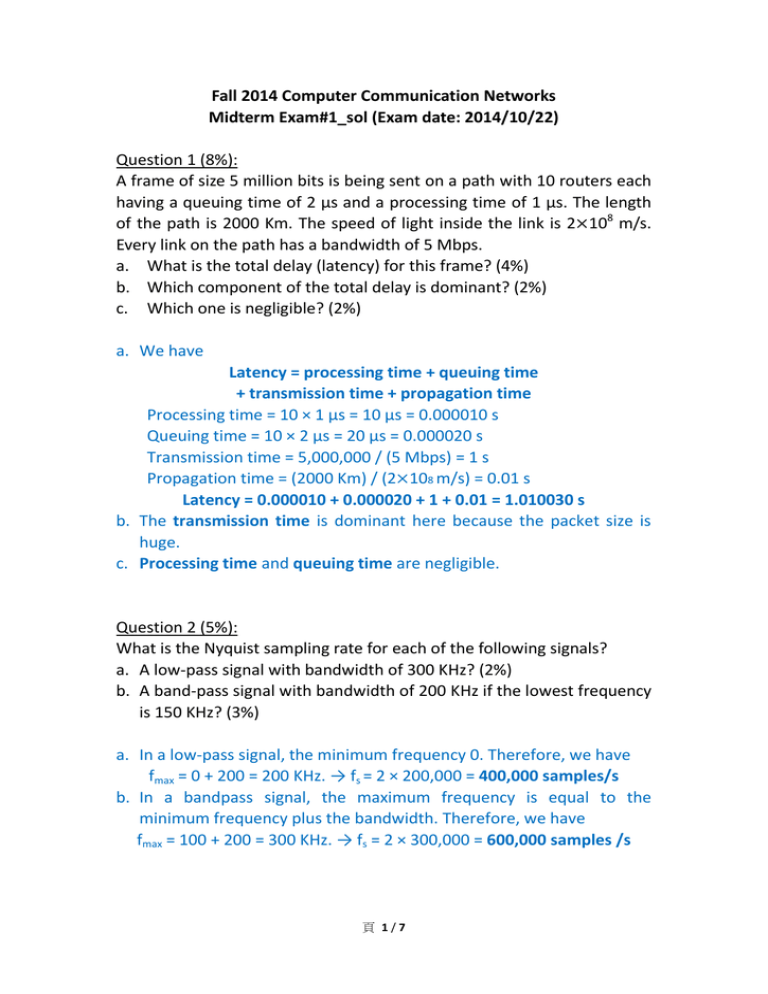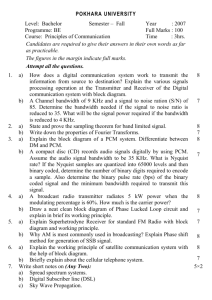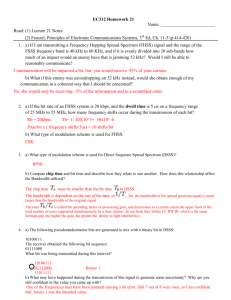Question 1
advertisement

Fall 2014 Computer Communication Networks Midterm Exam#1_sol (Exam date: 2014/10/22) Question 1 (8%): A frame of size 5 million bits is being sent on a path with 10 routers each having a queuing time of 2 μs and a processing time of 1 μs. The length of the path is 2000 Km. The speed of light inside the link is 2 108 m/s. Every link on the path has a bandwidth of 5 Mbps. a. What is the total delay (latency) for this frame? (4%) b. Which component of the total delay is dominant? (2%) c. Which one is negligible? (2%) a. We have Latency = processing time + queuing time + transmission time + propagation time Processing time = 10 × 1 μs = 10 μs = 0.000010 s Queuing time = 10 × 2 μs = 20 μs = 0.000020 s Transmission time = 5,000,000 / (5 Mbps) = 1 s Propagation time = (2000 Km) / (2× 108 m/s) = 0.01 s Latency = 0.000010 + 0.000020 + 1 + 0.01 = 1.010030 s b. The transmission time is dominant here because the packet size is huge. c. Processing time and queuing time are negligible. Question 2 (5%): What is the Nyquist sampling rate for each of the following signals? a. A low-pass signal with bandwidth of 300 KHz? (2%) b. A band-pass signal with bandwidth of 200 KHz if the lowest frequency is 150 KHz? (3%) a. In a low-pass signal, the minimum frequency 0. Therefore, we have fmax = 0 + 200 = 200 KHz. → fs = 2 × 200,000 = 400,000 samples/s b. In a bandpass signal, the maximum frequency is equal to the minimum frequency plus the bandwidth. Therefore, we have fmax = 100 + 200 = 300 KHz. → fs = 2 × 300,000 = 600,000 samples /s 頁 1/7 Question 3 (6%): We have sampled a low-pass signal with a bandwidth of 200 KHz using 1024 levels of quantization and the Nyquist sampling rate. a. Calculate the bit rate of the digitized signal . (3%) b. Calculate the PCM bandwidth of this signal. (3%) a. In a lowpass signal, the minimum frequency is 0. Therefore, we can say fmax = 0 + 200 = 200 KHz → fs = 2 × 200,000 = 400,000 samples/s The number of bits per sample and the bit rate are nb = log21024 = 10 bits/sample N = 400 KHz × 10 = 4 Mbps b. The value of nb = 10. The minimum bandwidth can be calculated as BPCM = nb × Banalog = 10 × 200 KHz = 2 MHz Question 4 (11%): We need a three-stage space-division switch with N=100. We use 10 crossbars at the first and third stages, and 4 crossbars at the middle stage. a. Calculate the total number of crosspoints. (3%) b. Find the maximum possible number of simultaneous connections. (3%) c. Find the maximum possible number of simultaneous connections if we use one single crossbar(100 100). (3%) d. Find the blocking factor, the ratio of the maximum number of simultaneous connections to 100 in parts c and d. (2%) a. 頁 2/7 b. The total number of crosspoints are Number of crosspoints = 10 (10 × 4) + 4 (10 × 10) + 10 (4 × 10) = 1200 c. Only four simultaneous connections are possible for each crossbar at the first stage. This means that the total number of simultaneous connections is 40. d. If we use one crossbar (100 × 100), all input lines can have a connection at the same time, which means 100 simultaneous connections. e. The blocking factor is 40/100 or 40 percent. Question 5 (5%): The attenuation of a signal is -10dB. What is the final signal power if it was originally 5W? –10 = 10 log10 (Pfinal / 5) log10 (Pfinal / 5) = −1 → (Pfinal / 5) = 10−1 Pfinal = 0.5 W Question 6 (8%): Suppose a 128-kbps point-to-point link is set up between the Earth and a rover on Mars. The distance from the Earth to Mars (when they are closest together) is approximately 55 Gm, and data travels over the link at the speed of light – 3 x 108 m/s. a. Calculate the bandwidth-delay product for the link. (4%) b. A camera on the rover takes pictures of its surroundings and sends these to Earth. How quickly after a picture is taken can it reach Mission Control on Earth? Assume that the size of a frame is 5MB. (4%) a. b. 頁 3/7 Question 7 (11%): Suppose that a low-pass communications system has a 1 MHz bandwidth. a. What bit rate is attainable without intersymbol interference using 8-level pulses (4%)? b. What is the Shannon capacity of this channel if the SNR is 20 dB? (4%) c. What is the Shannon capacity of this channel if the SNR is 40 dB? (3%) a. Nyquist pulses can be sent over this system at a rate of 2 million pulses per second. Eight-level signaling carries 3 bits per pulse, so the bit rate is 6 Mbps. b. C = 1000000 log2 (1 + 100) = 6.6 Mbps. c. C = 1000000 log2 (1 + 10000) = 13.3 Mbps. Question 8 (12%): Suppose that a frequency band W Hz wide is divided into M channels of equal bandwidth. a. What bit rate is achievable in each channel? (4%) b. What bit rate is available to each of M users if the entire frequency band is used as a single channel and TDM is applied? (4%) c. How does the comparison of a. and b. change if we suppose that FDM requires a guard band between adjacent channels? Assume the guard band is 10% of the channel bandwidth. (4%) a. Each user uses W/M bandwidth. Using Shannon’s Channel Capacity formula: Bit rate = b. In this case, the total bit rate afforded by the W Hz is divided equally among all users: Bit rate = c. Because of the guard band we expect that the scheme in (b) will be better since the bit rate in (a) will be reduced. In (a), the bandwidth usable by each channel is 0.9W/M. Thus, we have: Bit rate = 頁 4/7 Question 9 (8%): A non-periodic composite signal contains frequencies from 10 to 40 KHz. The peak amplitude is 20 V for the lowest and the highest signals and 30 V for the 20 KHz. Assuming that the amplitudes change linearly from the minimum to the maximum, draw the frequency spectrum. Question 10 (12%) Draw the graph of the NRZ-I, Manchester, MLT-3 streams, assuming that the last signal level has been positive. a. 00000000 b. 11111111 NRZ-I: Manchester: 頁 5/7 MLT-3: Question 11 (4%) The following figure show a switch in a virtual circuit network. Find out the output port and the output VCI for packets with the following input port and input VCI addresses: Packet 1: 3, 78 Packet 2: 2, 92 Packet 1: 2, 70 Packet 2: 1, 45 頁 6/7 Question 12 (10%): Show that a three-stage, N N space-division switch has a minimum number of cross points 4N [(2N)1/2 – 1] under the non-blocking criterion. Non-blocking criterion: Substitute into Let , we get . , we can conclude that the number of cross points has a minimum value 4N [(2N)1/2 – 1] when 頁 7/7 .




